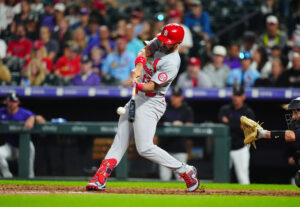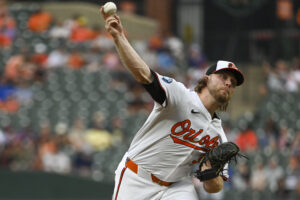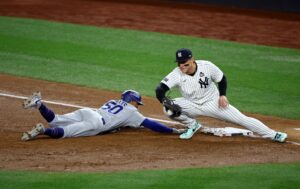The upcoming MLB season will be unlike any other. The league has implemented many new rules, from extra innings to the injured list. With the 60-game season, teams have some serious decisions to make. The Atlanta Braves prospects are no exception. With a rich system to delve into, the front office can easily make some decisions that can shape the future of the team. The only question is whether or not these young players can succeed.
Cristian Pache
Outfielder Cristian Pache currently ranks as the top prospect in the Braves system, and 13th overall. Pache’s potential in the field is certainly undeniable, receiving a scouting grade of 70. Pache has shown signs of supporting this grade with 868 career putouts in 922 chances. Last season, between Double-A Mississippi and Triple-A Gwinnett, he posted a fielding percentage of .985 and committed only four errors in 1,068 innings of work. He also added a range factor per nine innings of 2.26. His ample quality in the field could serve well for a Braves bench that may be limited this season.
Pache has showcased excellent speed (earning another scouting grade of 70), so he could definitely be used in a pinch-running scenario. He also carries a solid bat and can hit the ball over the fence on occasion. However, his plate discipline is where he could fall short. In 538 plate appearances last season, he walked just 43 times and struck out 122. He did post a .277 batting average with 135 hits, but his on-base percentage was .340. He hit .269 during spring training but only walked once in 28 plate appearances. With Adam Duvall, Marcell Ozuna, and Austin Riley all viable outfield options, his starting time would be severely limited. Nevertheless, his presence as a pinch-runner could be very valuable to the team.
Drew Waters
Drew Waters is second on the Braves top prospect list and 26th overall. Waters’ scouting scores reflect a player who can hit for average, run fairly well, and field his position. His biggest strength is the ability to hit from both sides of the plate. As of now, the Braves only have two switch-hitting options in Johan Camargo and Ozzie Albies. Since they receive regular playing time, it might benefit the team to have someone like Waters on the bench. Last year, he hit .309 between Mississippi and Gwinnett, with 40 doubles and 163 hits. He also added 16 stolen bases, thus giving a touch of speed to his repertoire.
As with Pache, his approach at the plate needs some work. His first spring training with the Braves proved to be a struggle, with a .167 average and only two walks in 26 plate appearances. He also struck out 14 times. Last year, he walked 29 times in 573 appearances while striking out 164 times. Even so, his high average and knack for hitting balls to the wall will help him once he reaches the majors. When he makes contact, he’s a dangerous hitter. When he doesn’t, he’s a strikeout magnet.
Ian Anderson
Ian Anderson is the Braves’ third-ranked prospect and ranks 37th in the minors. Anderson began last season with Gwinnett, and his numbers show that he may have been rushed. In five starts, he won just one game, while posting a 6.57 ERA and giving up 18 earned runs in 24.2 innings of work. While this is a small sample size, it is also an indicator of someone who may not quite be ready for the mound at Truist Park. However, when he was sent back to Mississippi, he flourished. In 21 starts he went 7-5 with a 2.68 ERA and only gave up 33 earned runs in 111 innings of work.
Anderson has certainly proven that he’s ready to take the next step. It’s simply a matter of garnering enough experience at the next level. Unfortunately, due to the canceled minor league season, that will not happen this year. His inclusion in the Braves player pool is not a surprise. The circumstances of the season call for as many players as possible. However, if he does get any big league exposure this year, it will come out of the bullpen. He might add some intrigue if he is called upon for the middle innings. His fastball has been graded at a 60, and his changeup at a 55. If he can mix those two pitches effectively, then he could provide trouble for opposing hitters. If not, then he might find himself in some trouble.
Kyle Wright
Kyle Wright is the Braves’ fourth top prospect and 52nd overall. Wright has had some big league experience but has been unable to stick around for an extended period. He began last season in the Braves rotation but had a rough first outing against the Philadelphia Phillies. While he only gave up three runs, his five walks were a concern. His career ERA of 7.71 in 11 games shows that he still has a lot of room for improvement. He gave up 22 earned runs in 25.2 innings of big league work, to go with 19 walks. So far, his total WAR is -0.5. As with Anderson, Wright may not quite be ready for big league assignments just yet.
However, Wright had a respectable minor league season in 2019. As a result, he went 11-4 in 21 starts for Gwinnett, posting a 4.17 ERA and giving up 52 earned runs in 112.1 innings. He also struck out 116 batters and walked only 35. If he can continue to improve on his control, he could become a force within the Braves rotation. He threw 201 strikes at the big league level last year, with nearly half of them coming on the first pitch. Executing strikes is the first step. Now it is simply a matter of taking his strengths and refining them.
Shea Langeliers
Shea Langeliers is the Braves’ fifth-ranked prospect and 70th overall. Langeliers was taken with the ninth overall pick in last year’s draft. This makes his inclusion in the initial player pool a very intriguing one and a very impressive one. He had a solid first year for Single-A Rome, hitting .255 with two home runs and 34 RBI in 54 games. He also added 55 hits and 13 doubles.
Langeliers spring training numbers were eye-popping. In eight games, he went 6-for-14 with a homer and five RBI. Of course, the quality of pitching he faced was only a 6.2, and it is also a very small sample size. But he shows a great deal of promise, especially when it comes to his defense. His arm score of 70 is a testament to that. He also threw out 41% of would-be base stealers. If he can continue to refine that quality, he could become a major asset.
But, his lack of experience could come back to haunt the Braves. His inclusion in the player pool is very surprising, considering his recent drafting. But, the consideration shows what kind of faith the team has in him. He could be used as a backup if Alex Jackson gets injured. But, other than that, he may not be used much this season. It is simply a testament to his raw talent and untapped potential that he has been put into such a position.
The Braves and Their Farm
Overall, the Braves have one of the deepest systems in the big leagues. With a laser-sharp focus on the mound, they have built a very bright future for their staff. That future could be realized as early as this season. Wright and Anderson might not be refined quite yet, but they could become viable options as this year and next year progress. When they are combined with other prospects like Bryse Wilson and Kyle Muller, it presents a lot of future assets.
Offensively, Pache and Waters are leading a young core that has a lot to be excited about. William Contreras and Langeliers are ample catching prospects, and Bryce Ball brings a healthy dose of power. But it will be the development of the outfielders that decides the fate of the young offense. A potential outfield of Ronald Acuña Jr., Pache, and Waters should make Braves fans thrilled about the future.
Main Photo:
Embed from Getty Images






